In the world of birds, many species eat other birds. This is called avivory or bird predation. It shows how complex predator-prey relationships exist among birds. From big raptors to birds in our yards, many birds eat other birds.
The Red-Shouldered Hawk, Cooper’s Hawk, and Sharp-Shinned Hawk are great hunters. They eat adult birds. The Fish Crow, American Crow, Blue Jay, and Common Grackle also eat the young of other birds.
Even smaller birds like the American Crow, Blue Jay, and Black-Capped Chickadee eat other birds’ eggs. Sometimes, they do this because they need a place to nest. For example, Black-Capped Chickadees have taken eggs from bluebird nests.
Key Takeaways
- A diverse range of bird species, from raptors to backyard birds, are known to prey on other birds.
- Avian predators can target adult birds, nestlings, and even eggs, driven by factors like food scarcity and competition for resources.
- The phenomenon of bird predation reveals the complex predator-prey relationships within the avian community.
- Understanding which birds are natural predators of other birds is crucial for appreciating the intricate dynamics of the avian world.
- The prevalence of bird predation underscores the challenging environment that birds face, with implications for their survival and conservation efforts.
Introduction to Avian Predators
In the vast world of birds, there’s a special group called avivores. These are animals that mainly eat other birds. They come from different groups like birds, mammals, amphibians, and some insects. Birds like falcons and accipiters are great at hunting and eating other birds.
Definition and Overview of Avivores
Avivores are animals that mainly eat other birds. They have special features like strong beaks and sharp claws. These help them catch and eat birds. They use different ways to hunt, like sneaking up or flying fast to catch their prey.
“Avivores are a fascinating group of predators, showcasing the remarkable evolution of specialized adaptations for hunting other birds.”
The Accipitriformes order, which includes hawks and eagles, started about 44 million years ago. This shows how long bird-eating animals have been around. Knowing about bird predation helps us understand how birds live together in nature.
Bird-Eating Raptors
Raptors, or birds of prey, are top bird-eaters in the wild. Falcons and accipiters are known for their amazing hunting skills.
Falcons: Peregrine Falcon Hunting Techniques
The peregrine falcon is famous for its fast diving attacks, called “stoops.” These dives can reach over 300 km/h (180 mph). They dive from high up to catch birds in mid-air.
With sharp talons and hooked beaks, they can easily grab and eat their prey.
Accipiters: Sharp-Shinned Hawk and Cooper’s Hawk Ambush Strategies
Accipiters, like the sharp-shinned hawk and Cooper’s hawk, are great at ambush hunting. They sneak up on their prey from hiding spots, then strike fast.
These bird-eating raptors show how well adapted and skilled these birds are at hunting.
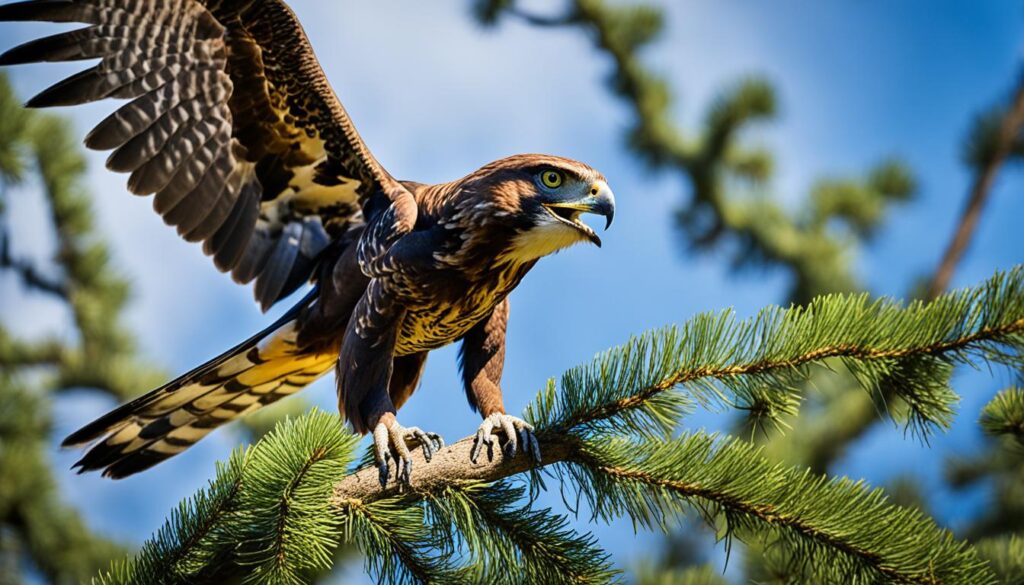
Backyard Birds that Hunt Other Birds
Most backyard birds eat insects, seeds, and plants. But, some birds hunt other birds too. The common grackle and the red-bellied woodpecker are two examples in North American yards.
Common Grackle: An Unexpected Avivore
The common grackle is a blackbird often seen in yards. It sometimes hunts and eats other adult birds, nestlings, and bird eggs. These urban avivores eat whatever they can find, including the young and eggs of other birds.
Red-Bellied Woodpecker: Eating Eggs and Nestlings
The red-bellied woodpecker is common in many yards. It has been seen taking eggs and chicks from other birds’ nests. Unlike most woodpeckers, it eats eggs and chicks as well as insects and plants.
“The common grackle and red-bellied woodpecker show that not all backyard birds just eat seeds. Some are skilled at hunting and eating other birds.”
Corvid Predators
Members of the corvid family, like crows and jays, prey on other birds. The American crow and the fish crow target eggs and nestlings of other birds. The blue jay, bold and opportunistic, raids nests of smaller birds for food.
American Crow and Fish Crow: Nest Predators
Studies reveal that removing corvids doesn’t greatly affect other bird species like gamebirds and ground-nesting birds. Sometimes, corvids even help other birds by controlling pests. Yet, crows are fierce nest predators, causing many bird nest failures.
Blue Jay: A Resourceful Nest Raider
The blue jay is a master at stealing eggs and young from smaller birds’ nests. In urban parks, nest predation rates can hit 53% to 92%. In suburbs, rates are lower, between 22% and 67%. The blue jay’s adaptability lets it survive and even thrive in human areas by raiding other birds’ nests.
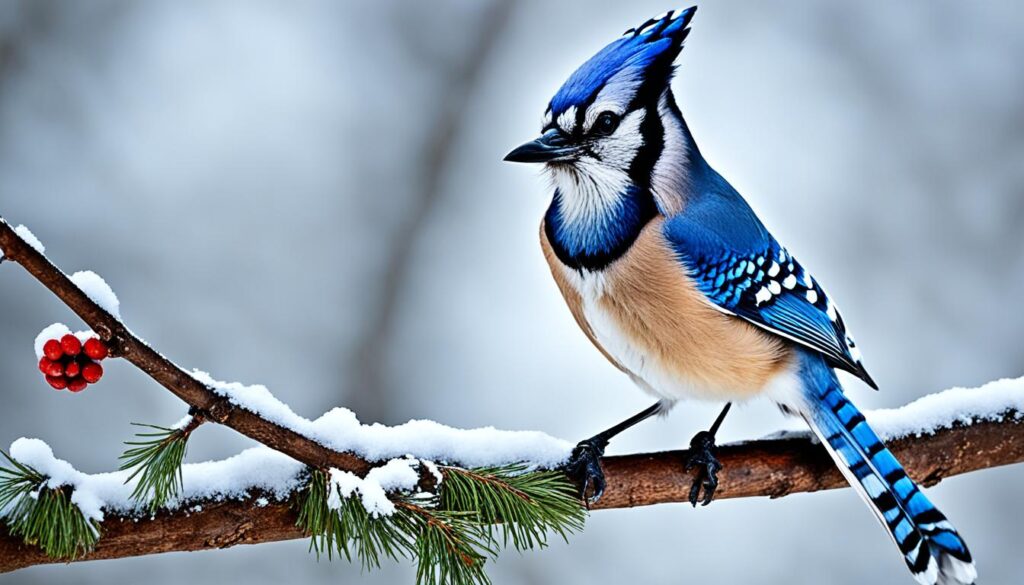
“Corvid removal often resulted in compensatory mortality, where other predators filled the gap in preying on the same species.”
Corvid predation’s impact on birds is complex, with both positive and negative effects. While they are major nest predators, their role in the ecosystem is complex. Understanding this is key to effective conservation strategies that protect all bird species.
Cats: A Formidable Bird Predator
Domestic and feral cats are big threats to wild birds. They kill between 1.3 and 4 billion birds each year in the U.S. These cats can sneak up and grab backyard bird predators with their sharp claws.
Domestic cats are loved pets but can harm bird populations if they roam free. Feral cats are worse since they hunt to survive and can destroy bird predation. Keeping cats away from bird-friendly areas helps protect birds.
“Cats are one of the most significant human-caused threats to birds in the United States and Canada. Keeping cats indoors is the best way to protect birds and other wildlife.”
To reduce cat predation on backyard birds, experts suggest these steps:
- Keep pet cats inside or in a safe outdoor area to stop them from hunting birds.
- Support programs to manage feral cat numbers, like trap-neuter-return.
- Make your backyard bird-friendly with thick plants and bird feeders cats can’t reach.
By doing these things, you can help keep nature balanced. This way, domestic cats and feral cats can live with bird predation in your area without harming birds.
Snake Predation on Birds
Snakes are skilled predators that target birds, including adults, young birds, and eggs. Many snakes can climb well, reaching bird nests in trees and high places. They can also swallow prey bigger than their heads, taking down even large birds.
Climbing Abilities and Tactics of Snake Predators
Snakes move quietly and set up ambushes, making them a big threat to birds in yards and nature. Snake predation is the top reason why bird nests fail, with snakes taking out about 26% of nests in North America.
- Rat snakes, corn snakes, and fox snakes are behind 70% of snake raids on bird nests.
- Rat snakes often target young birds at night, more so than eggs.
- Snake climbing and hunting tactics are more common in warmer areas. The success rate varies a lot depending on different factors.
“Predation by snakes is the leading cause of nest failure for nesting birds, with studies finding that snakes predated on an average of 26% of nests in North America.”
With many snake species and their skill at reaching avian nest predation, birds face a big threat. Knowing how snakes climb and hunt helps us protect bird nests better.
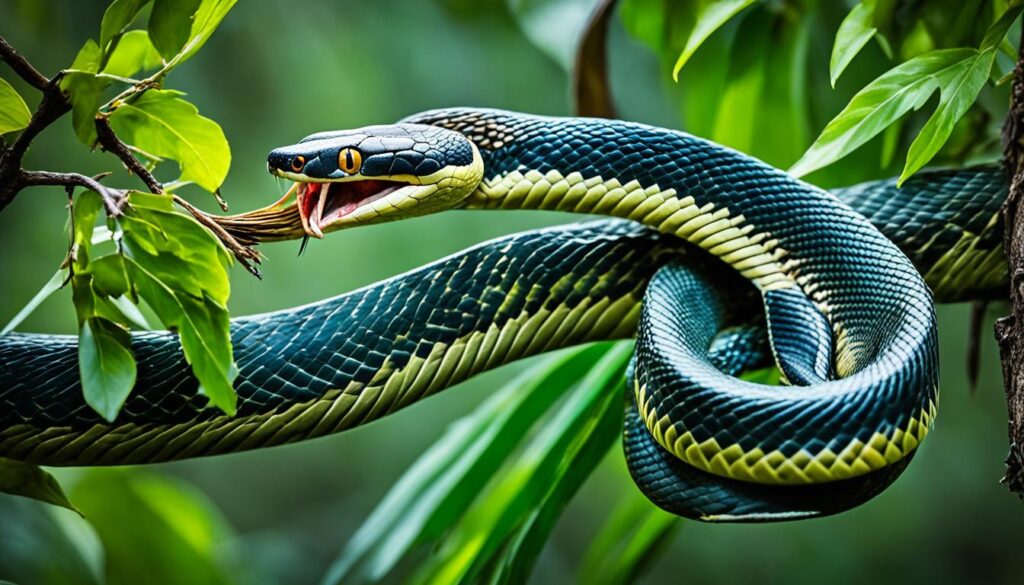
Squirrels: Opportunistic Egg and Nestling Thieves
Squirrels may seem harmless, but they can be a threat to birds’ nests. They are good at climbing trees and finding bird nests. They then eat eggs and nestlings without hesitation. Gray squirrels are especially known for this behavior.
Studies show that squirrel predation on eggs and nestlings is common. Many squirrel types, like Gray and Red Squirrels, eat bird eggs when they can. They are omnivores with a varied diet.
Some bird species are more at risk of squirrel nest raiding due to where they nest. Birds in open nests or high up are more likely to be attacked. But, adult birds usually can defend themselves against squirrels.
Squirrel predation doesn’t usually cause big problems for backyard birds. Birds face more threats from things like storms, droughts, and diseases. These threats often lead to more nest failures than squirrels do.
“Squirrels have been observed eating bird eggs when they encounter active nests.”
What birds eat other birds?
The world of birds is full of different species that eat other adult birds. These avian predators include everything from big raptors to common backyard birds.
Raptors: The Apex Avian Predators
Raptors like hawks, falcons, and eagles sit at the top of the bird food chain. They have sharp claws and beaks perfect for hunting. Accipiters, a type of hawk, are great at catching other birds. They use speed and surprise to do it.
Opportunistic Backyard Hunters
Even some backyard birds eat other adult birds. The common grackle eats smaller birds. The red-bellied woodpecker takes eggs and babies from other birds’ nests.
Corvids: The Cunning Nest Raiders
Corvids, which include crows, jays, and magpies, also eat adult birds. The American crow and fish crow go after eggs and young birds. The blue jay is good at stealing eggs and babies from other birds.
This shows how complex the bird world is. Even unexpected birds can be important in the ecosystem. Knowing about these relationships helps us protect birds.
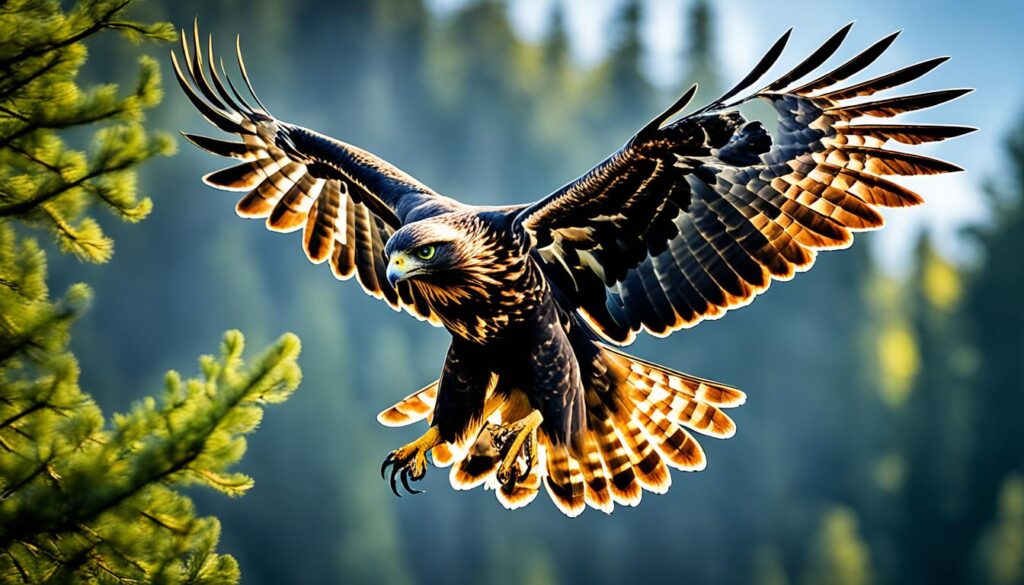
“The diversity of bird species that prey on other birds is a testament to the complexity and adaptability of the avian world.”
Insect Predators of Birds
Some insects are known to prey on birds, which might surprise you. The praying mantis is a great example. It’s an insect predator that can catch and eat small, fast birds like hummingbirds. These insects are skilled at catching birds that don’t see them coming.
Other insects also threaten birds. Mites and parasites can make birds weak or sick. This makes them easier targets for other bird predators. The balance between insects and birds is complex, with many predator-prey relationships in nature.
“Insects make up almost 80% of the diet for birds, with some bird species also consuming plant material, seeds, or fruits.”
The effect of insect predators on birds is crucial for conservation. Birds that eat insects, like swallows and martins, are declining. Understanding how insects affect bird populations is key to helping these birds.
Praying Mantis: A Surprising Hummingbird Hunter
The praying mantis is an unexpected bird predator. These insects can catch and eat hummingbirds, which is hard to believe. Their ambush tactics and strong grip let them take down these fast birds. This shows how insect predators have evolved to catch birds.
Mammals that Eat Birds
Besides birds of prey, mammals also hunt and eat birds. Carnivorous mammals like weasels, foxes, and others target adult birds, eggs, or young ones. They are known as mammalian avivores.
Carnivorous mammals are quick and skilled hunters. They raid nests for eggs and young or chase birds in the air or on the ground. These mammalian avivores change their hunting ways to fit the birds they hunt and where they live.
Weasels, Foxes, and Other Mammalian Avivores
Weasels are famous for being great bird predators. They sneak up and grab birds, often in backyard bird areas. Foxes are also good at hunting many bird types, both in nature and in cities.
Other mammalian avivores like raccoons, opossums, and coyotes eat birds, eggs, and young ones too. They use their sharp senses, quick moves, and determination to catch their prey.
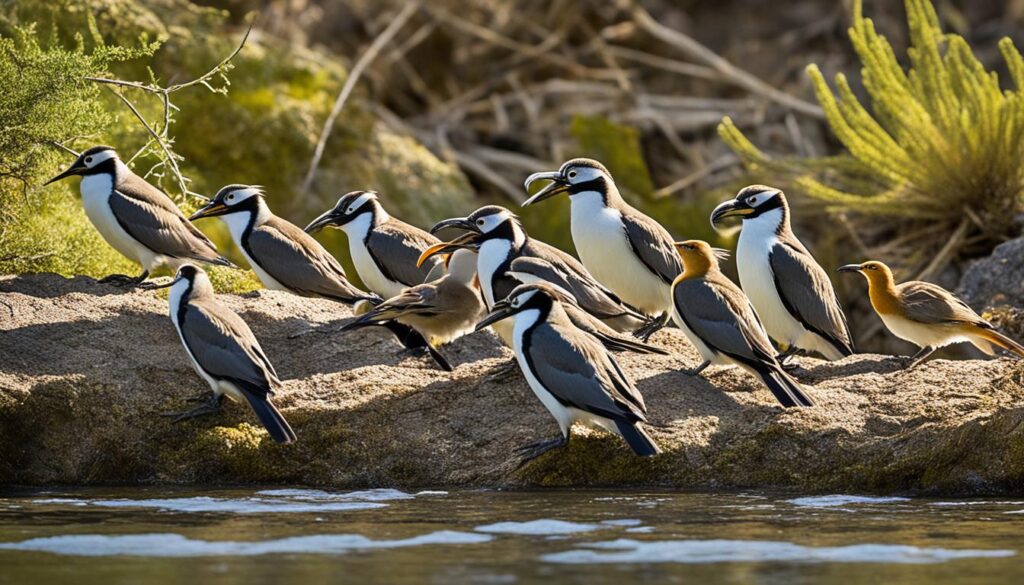
“Mammals are another group of animals that prey on birds, both as adults and in the form of eggs and nestlings.”
Mammalian avivores can greatly affect bird populations where they live together. Knowing how these carnivorous mammals hunt helps us protect backyard bird groups and keep ecosystems balanced.
Herbivores as Occasional Bird Predators
Most herbivores, like deer, eat plants. But some have been seen eating birds, too. This shows how adaptable some herbivores can be.
Deer Eating Bird Chicks: An Unexpected Behavior
Deer usually eat leaves, stems, and grasses. But when food is scarce, they might eat small animals, like bird chicks. This herbivore predation on bird chick predation shows how some herbivores eat both plants and animals.
Scientists think deer eat young birds when plants are hard to find or when they need more nutrients. By eating bird chicks, deer can get what they need and adjust to their environment.
“The discovery of deer feeding on bird chicks is a fascinating example of the adaptability and flexibility of some herbivorous animals. It underscores the complex and interconnected nature of ecosystems, where predator-prey relationships can extend beyond traditional boundaries.”
Watching animals, we see how herbivore predation on bird chick predation shows nature’s surprises. It reminds us that animals can change and adapt in amazing ways. This shows how strong and flexible nature is.
Protecting Backyard Birds from Predators
Keeping the birds that come to your backyard safe is key for their health. By using different ways to keep predators away and making bird-friendly areas, you can make a safer place for them.
Deterrent Strategies
One good way to keep predators away is to block their hiding spots. Seal any holes or gaps that could be used by cats, snakes, and squirrels. Also, using motion-activated sprinklers or repellents can scare off these animals from your bird feeders.
Safe Habitat Design
Creating a backyard that offers birds safe places to hide and rest is crucial. Putting bird predator deterrents like native plants, bushes, and trees near your feeders helps smaller birds escape from hawks. Keeping your bird houses and feeders clean and in good spots also helps make a safe bird habitat.
“By creating a backyard that is both inviting and secure for our feathered friends, we can play a vital role in backyard bird conservation and preserve the natural beauty that these creatures bring to our outdoor spaces.”
Even though birds at backyard feeders face risks, we can help by stopping predators and making safe bird habitats. This helps protect the backyard birds that visit our yards.
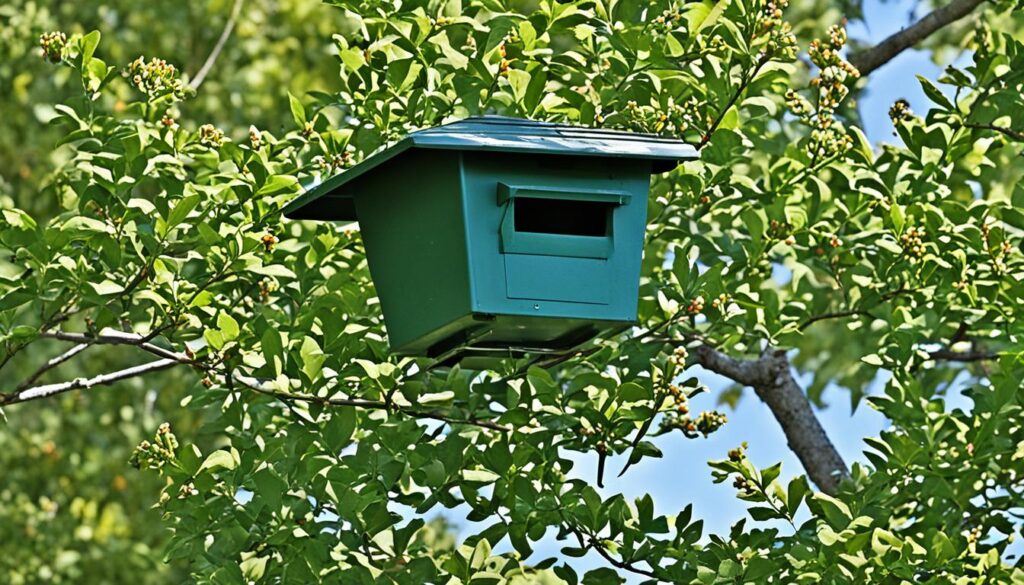
Impact of Avian Predation
Predation is a key part of the bird world. It helps control bird numbers and keeps species healthy. Losing some birds to predators is normal. It usually happens to the old, weak, or less fit ones.
But, too much predation can be a problem for birds already struggling. This includes those facing habitat loss or other human issues.
The ecological role of predation is big. It keeps prey populations in check and balances the ecosystem. For example, in 2015, birds ate about 35 percent of young spring Chinook salmon in the Upper Columbia River. This shows how avian predation affects fish populations.
On the flip side, fewer predators can hurt bird conservation efforts. The Caspian Tern and Double-crested Cormorant populations have dropped a lot in the Columbia Plateau. This change in predator-prey dynamics can upset the ecosystem balance.
Knowing about avian predation is key for saving threatened birds. Groups like Bird Research Northwest study bird colonies. They look at size, distribution, and other important factors. This info helps with bird conservation and managing predator-prey dynamics.
“Predation is a natural and essential part of the avian ecosystem, playing a crucial role in shaping bird populations and communities.”
Conclusion
Many animals, like raptors, corvids, cats, snakes, and insects, prey on birds. This shows how complex the relationship between birds and their predators is. Seeing birds become prey can be tough, but it’s crucial for the ecosystem.
By learning about the avivores‘ hunting ways, we can help protect birds. This helps us understand how predation affects bird populations. It also helps us find ways to save birds at risk.
Living with avian predators and keeping ecosystems healthy is vital for bird conservation. Birds are key to keeping nature in balance. By understanding their world, we can protect our bird friends and the ecosystems they live in.
We can help by feeding birds responsibly, saving their homes, and valuing their role in nature. This keeps the balance between birds and their predators right. It lets these amazing birds live and flourish for years to come.
FAQ
What birds are known to prey on other birds?
Many bird species hunt and eat other adult birds. Raptors like hawks and eagles do this. So do some backyard birds, like grackles and woodpeckers. Accipiters, a type of hawk, are experts at catching and eating other birds.
What are avivores and what types of animals are considered avivores?
Avivores are birds that mainly eat other birds. They include raptors and some backyard birds. These predators can be birds, mammals, amphibians, or even insects.
How do falcons and accipiters hunt and capture other birds?
Falcons, like the peregrine falcon, are known for their fast dives to catch birds in mid-air. Accipiters, including the sharp-shinned hawk, sneak up on their prey from hiding. They strike quickly to catch birds off guard.
What backyard bird species are known to prey on other birds?
The common grackle sometimes hunts and eats other adult birds. It also goes after nestlings and eggs. The red-bellied woodpecker raids other birds’ nests for eggs and chicks.
How do corvids like crows and jays prey on other birds?
Crows and jays, part of the corvid family, eat the eggs and young of other birds. The American and fish crows target eggs and nestlings. The blue jay is a nest raider, taking eggs and chicks from smaller birds.
How do domestic and feral cats impact bird populations?
Cats, both pets and feral, are big threats to wild birds. They kill billions of birds each year in the U.S. Cats are stealthy hunters, catching birds with their sharp claws.
How do snakes and squirrels prey on birds?
Snakes climb trees to get to bird nests, where they eat eggs and young. Squirrels also climb trees to find and eat the contents of bird nests.
What other animals, besides birds, are known to prey on birds?
Many animals, like mammals and insects, eat birds. Weasels and foxes hunt birds. Praying mantises and even white-tailed deer have been known to eat bird chicks.
How can backyard bird enthusiasts protect their feathered visitors from predators?
To keep birds safe, limit places for predators to live and hide. Use deterrents and create bird-friendly areas with lots of cover. Clean and maintain bird houses and feeders to make your yard safer for birds.
What is the ecological role of avian predation, and how does it impact bird conservation?
Predation is key to the bird world, helping to keep populations healthy. It targets older or weaker birds, which helps the species overall. But too much predation can hurt bird populations, especially if they’re already struggling due to habitat loss or other human actions.
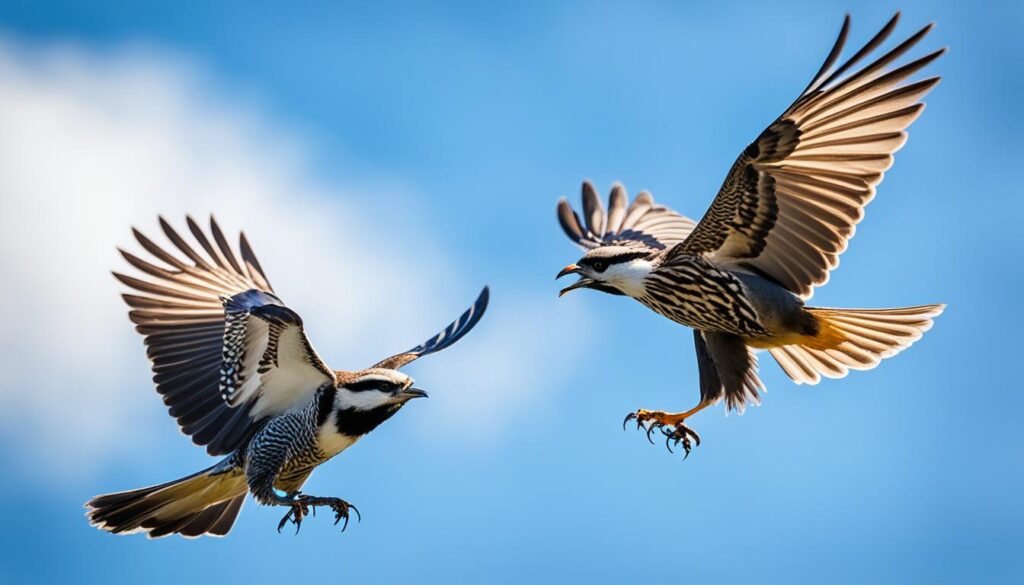

Heya i’m for the first time here. I came across this board and I find It really useful & it helped me out much.
I’m hoping to provide one thing again and aid others such as you helped me.
Also visit my webpage; nordvpn coupons inspiresensation – http://da.gd –
nordvpn coupons inspiresensation 350fairfax
Hi this is somewhat of off topic but I was wanting to know if blogs
use WYSIWYG editors or if you have to manually code with HTML.
I’m starting a blog soon but have no coding experience so I wanted to get advice from someone with experience.
Any help would be enormously appreciated!